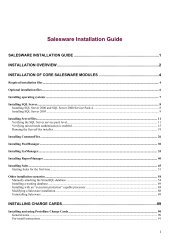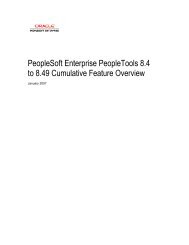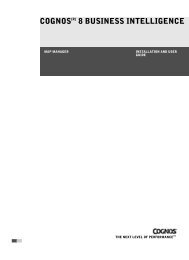Cognos ReportNetTM Installation and Configuration Guide
Cognos ReportNetTM Installation and Configuration Guide
Cognos ReportNetTM Installation and Configuration Guide
You also want an ePaper? Increase the reach of your titles
YUMPU automatically turns print PDFs into web optimized ePapers that Google loves.
Appendix A: Manually Configuring ReportNet<br />
You should now use a validating XML editor to validate your changes against the rules in the<br />
crnstartup.xsd file, located in the crn_location/configuration.<br />
Add a Component to Your <strong>Configuration</strong><br />
The crnstartup.xml file contains configuration settings used by ReportNet <strong>and</strong> by default<br />
third-party components.You can change the components that ReportNet uses by copying XML<br />
elements from sample files into the crnstartup.xml file. You can then edit the configuration<br />
values to suit your environment.<br />
For example, to use an Oracle database instead of a Microsoft SQL Server database for the<br />
content store, you can use the ContentManager_language code.xml sample file to replace the<br />
default database connection information.<br />
ReportNet can use only one instance at a time of the following elements:<br />
• the database for the content store<br />
• a cryptographic provider<br />
• a configuration template for the ReportNet service<br />
You should be familiar the structure of XML files before you start editing them.<br />
Steps<br />
1. Go to the crn_location/configuration/samples directory.<br />
2. Choose a sample file to open in an editor:<br />
• To use Oracle or DB2 for the content store, open the<br />
ContentManager_language_code.xml file.<br />
• To use an authentication provider, open the Authentication_language_code.xml file.<br />
• To use a third-party cryptographic provider, open the Cryptography_language_code.xml<br />
file.<br />
• To send log messages somewhere other than a file, open the<br />
Logging_language_code.xml file.<br />
• To use a medium or large template for the amount of resources the ReportNet process<br />
uses, open the ReportNetService_language_code.xml file.<br />
3. Copy the elements that you need.<br />
Tip: Ensure that you copy the code including the start <strong>and</strong> end tags for the <br />
element.<br />
For example, look for the (Begin of) <strong>and</strong> (End of) comments:<br />
<br />
<br />
...<br />
<br />
<br />
4. Go to the crn_location/configuration directory.<br />
5. Open the crnstartup.xml file in an editor.<br />
6. Paste the code from the sample file to the crnstartup.xml file <strong>and</strong> replace the appropriate<br />
element.<br />
7. Change the values of these new elements to suit your environment.<br />
For the element, don’t change the class attribute. You can change the name<br />
attribute to suit your environment.<br />
For example, if you use an Oracle database for the content store, change only the name<br />
attribute to suit your environment.<br />
<br />
8. Save <strong>and</strong> close the file.<br />
104 <strong>Cognos</strong> ReportNet TM
















